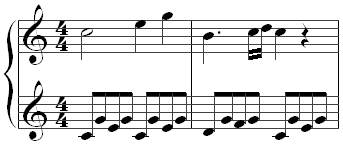Alberti bass: Difference between revisions
No edit summary |
No edit summary |
||
| Line 29: | Line 29: | ||
[[uk:Альбертієви баси]] |
[[uk:Альбертієви баси]] |
||
ta da |
ta da |
||
hello |
|||
Revision as of 19:19, 17 September 2009
Alberti bass is a particular kind of accompaniment in music, often used in the Classical era, and sometimes the Romantic era. It was named after Domenico Alberti (1710-1740), who used it extensively, although he was not the first to use it.[1]
Alberti bass is a kind of broken chord or arpeggiated accompaniment, where the notes of the chord are presented in the order lowest, highest, middle, highest. This pattern is then repeated.[1]
Alberti bass is usually found in the left hand of pieces for keyboard instruments, especially for Mozart's Piano Pieces. However, it is also found in pieces for other instruments. For example Béla Bartók uses it towards the end of his String Quartet No. 5.
A well known example of Alberti bass is found at the beginning of Wolfgang Amadeus Mozart's Piano Sonata, K 545:[2]
References
ta da hello


